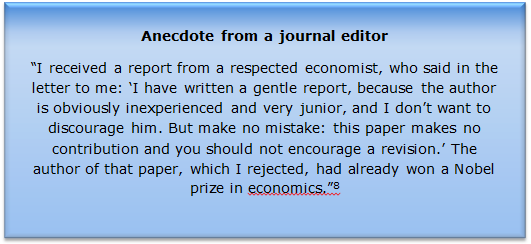Most common reasons for journal rejection

Rejection is the norm in academic publishing. Even researchers at the top of their field have experienced rejection. Several peer-reviewed studies have investigated the reasons that journals reject papers. Listed below are the most common rejection reasons cited in these studies.1-13
Lack of originality, novelty, or significance
1. Results that are not generalizable
2. Use of methods that have become obsolete because of new technologies or techniques
3. Secondary analyses that extend or replicate published findings without adding substantial knowledge
4. Studies that report already known knowledge but positions the knowledge as novel by extending it to a new geography, population, or cultural setting
5. Results that are unoriginal, predictable, or trivial
6. Results that have no clinical, theoretical, or practical implications
One of America’s leading newspapers, the New York Times, recognized the truth that “journal editors typically prefer to publish groundbreaking new research.”14 Academic journals are constantly on the lookout for research that is exciting and fresh. Many authors tend to cite the reason that “this has never been studied before” to explain why their paper is significant. This is not good enough; the study needs to be placed in a broader context.
Authors should give specific reasons why the research is important, for example, the research could affect a particular medical intervention, it could have a bearing on a specific policy discussion, or it could change a conventional theory or belief.
Mismatch with the journal
1. Findings that are of interest to a very narrow or specialized audience that the journal does not cater to specifically
2. Manuscripts that lie outside the stated aims and scope of the journal
3. Topics that are not of interest to the journal’s readership
4. Manuscripts that do not follow the format specified by the journal (e.g., case report submitted to a journal that explicitly states it doesn’t publish case reports)
Many manuscripts are rejected outright by journals, before they even undergo peer review, because the manuscript is not appropriate for the journal’s readership or does not fit into the journal’s aims and scope. The remedy for this is simple: spend some time in choosing the accurate journals for submitting you paper. You can start by creating a list of journals and reviewing your options before deciding which journal to submit your manuscript to.
Flaws in study design
1. Poorly formulated research question
2. Poor conceptualization of the approach to answering the research question
3. Choice of a weak or unreliable method
4. Choice of an incorrect method or model that is not suitable for the problem to be studied
5. Inappropriate statistical analysis
6. Unreliable or incomplete data
7. Inappropriate or suboptimal instrumentation
8. Small or inappropriately chosen sample
Even a well-written paper will not mask flaws in study design. Indeed, this is a fundamental problem that must be resolved in the initial stages of the study, while conceptualizing the study. The best way to guard against such flaws is to do a thorough literature review to determine the best methodologies and practices for your own research.
Poor writing and organization
1. Inadequate description of methods
2. Discussion that only repeats the results but does not interpret them
3. Insufficient explanation of the rationale for the study
4. Insufficient literature review
5. Conclusions that do not appear to be supported by the study data
6. Failure to place the study in a broad context
7. Introduction that does not establish the background of the problem studied
It is very important for authors to present a persuasive and rational argument in their papers. You should be able to convince readers that your research is both sound and important through your writing.
Inadequate preparation of the manuscript
1. Failure to follow the journal’s instructions for authors
2. Sentences that are not clear and concise
3. Title, abstract, and/or cover letter that are not persuasive
4. Wordiness and excessive use of jargon
5. Large number of careless errors like poor grammar or spelling mistakes
6. Poorly designed tables or figures
Non-English-speaking authors often confront an additional problem: peer reviewers do not always distinguish between the manuscript content and style of writing. Thus, their manuscripts may end up getting negative comments even if the research is of high quality.15
However, all the problems in this category are easily fixable, either by asking a native English speaking friend or colleague to review the paper or by getting the paper professionally edited and formatted.
Check out this article: The complete guide to writing a brilliant research paper
Rejection reasons not related to manuscript quality
Low quality of the manuscript is not the only reason for rejections. Some major factors that can also affect journal decisions are: 8,11,16,17
1. Space constraints
It is not uncommon for journals to reject high-quality manuscripts, and the primary reason for this is lack of space. Journals want to publish on a range of topics that represent the entire scope of the journal. Editors of print journals especially have to pick and choose which papers to publish, since they can only publish a limited number of articles. Open access journals are less constrained by this consideration since space is not a big issue for them.
2. Quality and experience of peer reviewers
The quality of peer review varies widely according to reviewers’ professional experience, educational background, research interests, etc.
3. Volume of submissions
For obvious reasons, journals that attract a large number of submissions will also reject a large number of manuscripts. For example, Nature receives 10,000 submissions a year, making the rejection of even high quality manuscripts inevitable.
4. Journal’s decision-making policy
This varies widely among journals. For example, some journals follow a policy of rejecting any manuscript that will require major revisions, while some journals will complete another round of peer review if they are unsure of the manuscript's quality.
5. The journal editor is looking for something specific at a particular time
Sometimes, journal editors may wish to publish a thematic issue of the journal or may be interested in a current hot topic, in which case they might tend to accept more papers focusing on that particular topic.
6. The journal receives more than one submission on the same topic
In such cases, the journal may well choose to publish only one of the manuscripts, rejecting the other for no other reason than that they already have a paper on a similar topic.

Conclusion
There are many reasons that journals reject manuscripts for publication, some due to the quality of the research or manuscript, and some due to completely avoidable reasons like mismatch with the journal. Further, it is not rare for journals to reject even high-quality manuscripts simply because of space constraints or other issues. The reasons given above are some of the most common reasons for rejection, but they are not the only ones. Other reasons include salami publications, non-conformance to ethics policies, and plagiarism.
Related reading:
- Should I throw away my rejected manuscript?
- 8 Reasons why journals reject manuscripts
- How to improve a manuscript that has been rejected by 4 journals?
Bibliography
1. Coronel R (1999). The role of the reviewer in editorial decision-making. Cardiovascular Research, 43(2): 261-264. doi: 10.1016/S0008-6363(99)00177-7.
2. Ehara S & Takahashi K (2007). Reasons for rejection of manuscripts submitted to
3. AJR by international authors. American Journal of Roentgenology, 188(2): W113-6. doi: 10.2214/AJR.06.0448.
4. Byrne DW (2000). Common reasons for rejecting manuscripts at medical journals: A survey of editors and peer reviewers. Science Editor, 23(2): 39-44.
5. Bordage G (2001). Reasons reviewers reject and accept manucripts: The strengths and weaknesses in medical education reports. Academic Medicine, 76(9): 889-96.
6. Wyness T, McGhee CN, Patel DV (2009). Manuscript rejection in ophthalmology and visual science journals: Identifying and avoiding the common pitfalls. Clinical & Experimental Ophthalmology, 37(9): 864-7. doi: 10.1111/j.1442-9071.2009.02190.x.
7. McKercher B, Law R, Weber K, Song H, Hsu C (2007). Why referees reject manuscripts. Journal of Hospitality & Tourism Research, 31(4): 455-470. doi: 10.1177/1096348007302355.
8. Pierson DJ (2004). The top 10 reasons why manuscripts are not accepted for publication. Respiratory Care, 49(10): 1246-52.
9. Mcafee RP (2010). Edifying Editing. The American Economist, 55(1): 1-8.
10. Smith MU, Wandersee JH, Cummins CL (1993). What's wrong with this manuscript?: An analysis of the reasons for rejection given by Journal of Research in Science Teaching reviewers. Journal of Research in Science Teaching, 30(2): 209-211. doi: 10.1002/tea.3660300207.
11. Ajao OG (2005). Some reasons for manuscript rejection by peer-reviewed journals. Annals of Ibadan Postgraduate Medicine, 3(2): 9-12.
12. Ali J (2010). Manuscript rejection: Causes and remedies. Journal of Young Pharmacists, 2(1): 3-6. doi: 10.4103/0975-1483.62205.
13. Turcotte C, Drolet P, Girard M (2004). Study design, originality and overall consistency influence acceptance or rejection of manuscripts submitted to the Journal. Canadian Journal of Anesthesia, 51(6): 549-56. doi: 10.1007/BF03018396.
14. Carpenter WT, Thaker GK, Shepard PD (2010). Manuscript rejection for the Schizophrenia Bulletin: Some reasons. Schizophrenia Bulletin, 36(4): 649-650. doi: 10.1093/schbul/sbq056.
15. Zimmer C. It’s science, but not necessarily right. The New York Times. June 25, 2011.
16. Kumar M (2009). A review of the review process: manuscript peer-review in biomedical research. Biology and Medicine, 1(4): 1-16.
17. Schultz DM (2010). Rejection rates for journals publishing in the atmospheric sciences. Bulletin of the American Meteorological Society, 91(2), 231-243. doi: 10.1175/2009BAMS2908.1.
18. House of Commons Science and Technology Committee (2011). Peer review in scientific publications Vol 1. House of Commons: London, UK.
Published on: Nov 12, 2013
Comments
You're looking to give wings to your academic career and publication journey. We like that!
Why don't we give you complete access! Create a free account and get unlimited access to all resources & a vibrant researcher community.

Subscribe to Journal Submission & Peer Review











![Tips to avoid journal rejection [Free e-book for researchers] Tips to avoid journal rejection [Free e-book for researchers]](https://cdn.editage.com/insights/editagecom/production/styles/card_image/public/Tips%20to%20avoid%20journal%20rejection%20%5BFree%20e-book%20for%20researchers%5D%20%28original%29_0.jpg?itok=6iDJ5TjO)

